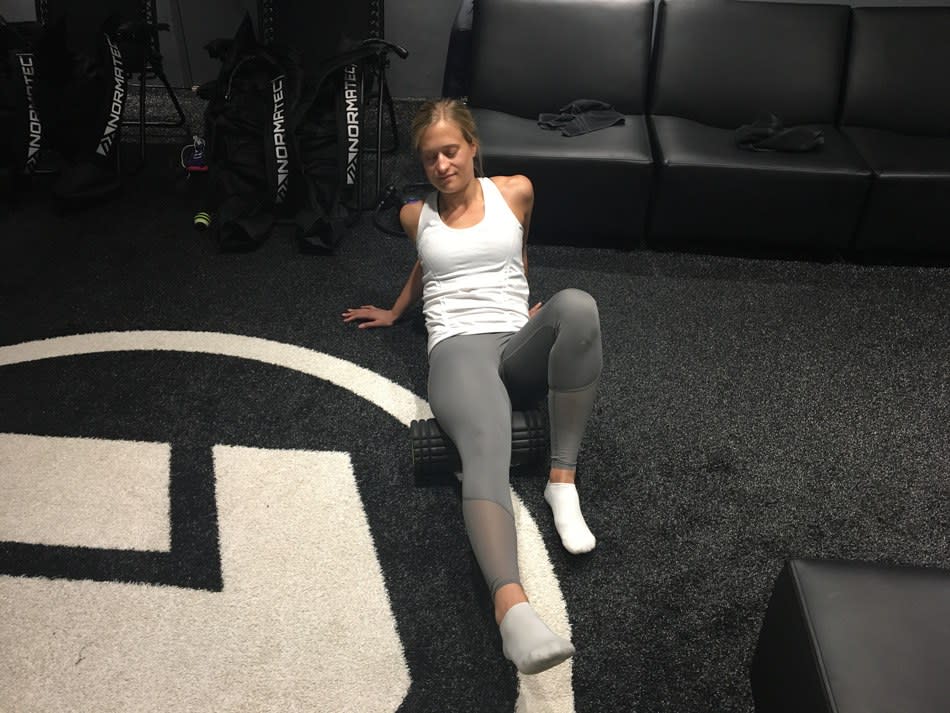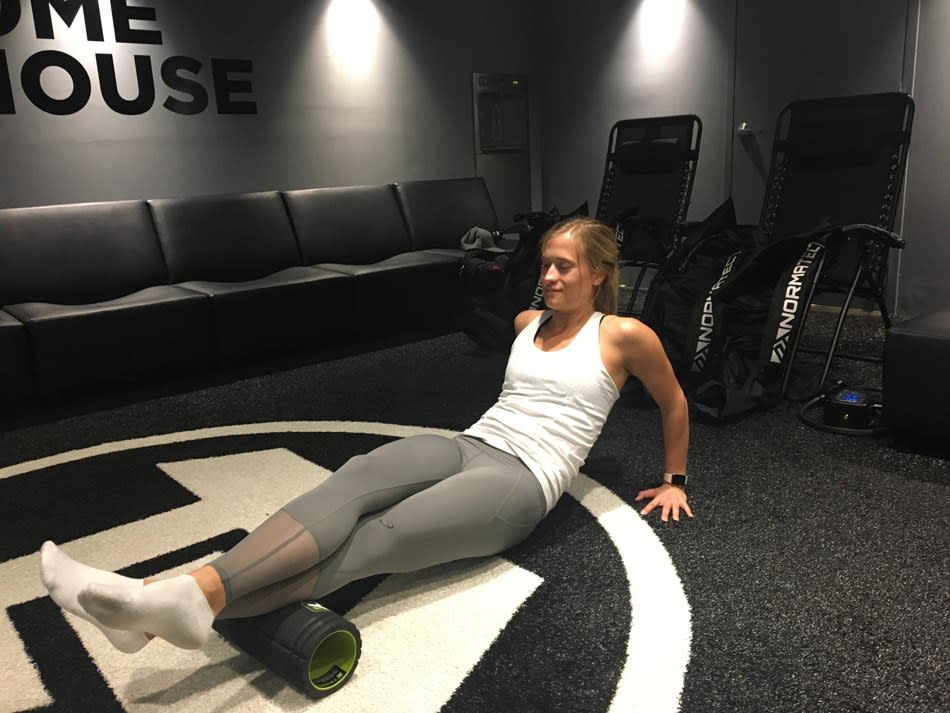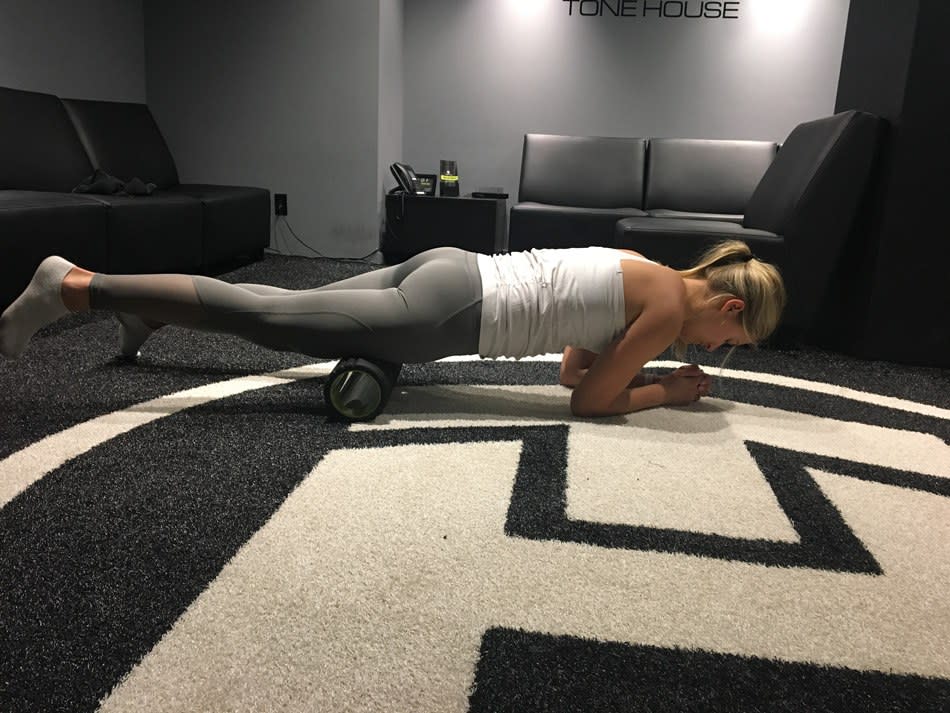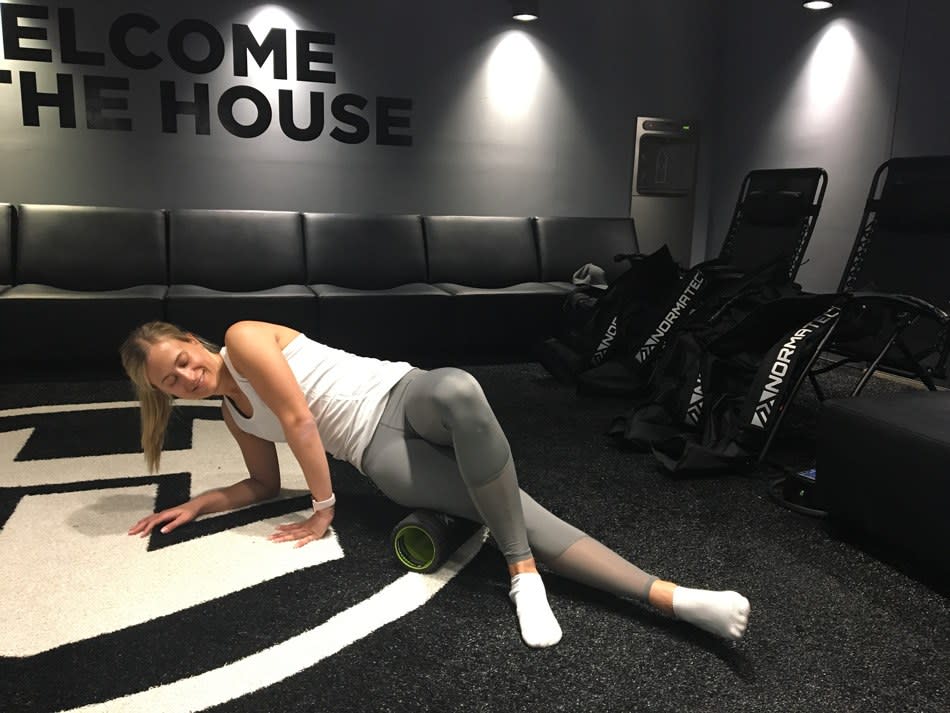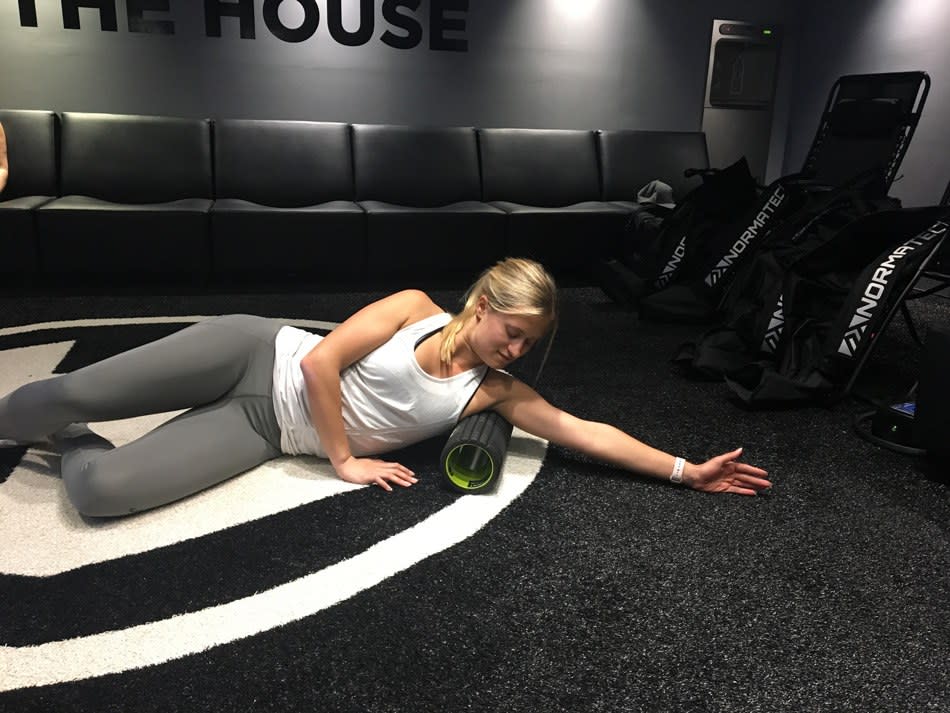I Took a Foam-Rolling Class and My Life Will Never Be the Same
By Amy Marturana. Photos: Courtesy of author.
Confession: I never use a foam roller. That may not seem like a huge, juicy reveal to you, but when I admitted that to my editor (who is a certified personal trainer), she gasped audibly. How could someone who's a runner and a fitness editor NOT use a foam roller?! The answer? Because no one has convinced me that it's worth my time.
Some days, it takes a lot of schedule hacking and sacrificing to just fit in a quick workout. Like, a lot. And when you're squeezing it in right before work or between work and a doctor's appointment or a friend's birthday dinner or a dress fitting for the wedding you're in this month, it's hard to have the time to even wash your hair after. I always do a few quick stretches after my workouts before I run off to the next thing. But foam rolling has always just sounded like extra work, so I've ignored its existence.
Until, being the runner and fitness editor that I am, I started hearing about gyms offering recovery classes meant to optimize muscle recovery after hard workouts. People are now paying to foam roll. Which made me think, finally, that maybe I should be getting on board with the recovery tool so many fitness fiends swear by.
I called group fitness studio Tone House in New York City to book a spot in their newish Recovery class. Here's how it helped make a believer out of this skeptic.
First, I called a physical therapist to get the rundown on if and how foam rolling works.
I needed to get more info on foam rolling before I did it. I've read about it on the Internet, but I had never looked into actual research or spoken to any experts about what it does and if or why it works. Dan Giordano, D.P.T., C.S.C.S., cofounder of Bespoke Treatments Physical Therapy, reassured me with a resounding yes that foam rolling is a good idea.
He explains that foam rolling is a form of self-myofascial release, "which is basically a form of self-massage." Fascia is the thin tissue that connects our muscles—kind of like the glue that holds the insides of our body together. Just like a massage, foam rolling helps break up knots in this tissue and release tension.
There's a decent amount of research out there on self-myofascial release that suggests it has positive effects ranging from increased flexibility to enhanced recovery. But the benefits of using a foam roller specifically for this purpose have only recently begun to be studied. So far, studies suggest that it can help increase range of motion and decrease muscle soreness after an intense bout of exercise, but the research is still very limited.
Giordano explains: "Foam rolling has been shown to increase flexibility and circulation (blood flow and oxygen), remove muscle tension, improve performance, reduce stress, and even reduce cellulite by restoring tissue elasticity. By increasing circulation, the tissues will ultimately heal faster, which will allow you to move onto your next workout in a faster manner and in better condition." So by foam rolling, I could feel less sore and my muscles would repair quicker, so I could get even more out of my next workout instead of half-assing my squats because my quads are so sore.
At Tone House, I spent 30 minutes rolling out my entire body with a foam roller.
Yusuf Jeffers, a NASM-certified personal trainer and head coach at Tone House, walked me through every step of foam rolling. First, he reassured me that it's not really bad that I don't foam roll. But it could help me.
"If you're doing a highly repetitive movement such as running, especially if things aren't in perfect balance, you're typically overusing some muscles or they just get fatigued over time. And then you're underusing some," Jeffers says. "The ones that get overused tend to get tight, and a tight muscle doesn't function properly." When you foam roll, you can loosen the tight muscles and any knots (or "adhesions") in the fascia so that the body can function as it should.
The way you do it is simple. Pick a big muscle group, and lie with your body on top of the roller so you can control the pressure. Roll up and down and side to side, slowly, to find the spots that feel tight and uncomfortable. Pause for a couple seconds there, and then continue rolling. "Just make it a slight pause, otherwise it can be too painful and you don’t want to bruise yourself," Giordano says. (He's right—I found a quarter-sized bruise on the side of my quad a few days later, momentarily panicked wondering where it came from, and then remembered this fun exercise in masochism.)
Foam rolling a tight spot will ache—you're literally pressing into a sore spot, which hurts so bad it feels good—but if you ever feel like you're actually in pain, shift your body weight to take some pressure off. "Listen to your body," Giordano says. It should feel like a massage—one that hurts so good, not one that just plain hurts.
Jeffers also says I should avoid rolling on my joints or anything hard. "You want to stay where the muscle is," he says. Why? Well, foam rolling a bone isn't going to help anything, and it's just going to put unnecessary pressure on areas that take enough of a beating during high-impact exercises. You should also never foam roll your lower back. "Direct pressure on the lumbar spine can cause muscles surrounding the spine to go into spasms," Giordano adds.
I foam rolled my feet, calves, quads, butt, and arms. It felt really good...and also hurt like hell.
I went on my foam-rolling spree a few days after returning from an epic hiking trip in Yosemite. So most of the muscles in my legs were pretty damn tight.
"You'll find you have some spots you need to roll more than others," Yusuf says. Everyone is built differently. Any muscle imbalances (one side is slightly more developed than the other) can make it so that a muscle on one side of your body is totally fine, but the muscle on the other side of the body is tender. Over time, you may need to use a denser roller or even graduate to ones with ribbing on it to really target your sore spots.
What I learned: The arches of my feet need some serious TLC (thanks, running). My calves are insanely tight. So is the outer side of my quads. My hamstrings are not tight at all, and neither are my arms or butt. It made perfect sense, considering my recent hiking trip and the barre class I took the morning before this.
What Yusuf concluded: "So far from what I can tell, you're doing a lot of calf stuff and a lot of quad-dominant things, and not as much glute work probably. So I'd say keep going to barre class."
My final question: Can you ever foam roll too much?
Both experts said not really, but foam rolling too hard can definitely leave you bruised. To avoid that, you really should just listen to your body and if the pressure feels unbearable, lay off a bit, Giordano says.
Both experts also tell me that ideally, one should foam roll after all workouts. Giordano also adds that some research suggests doing it before a workout (in conjunction with a dynamic warmup) can help further increase performance, but there's not much conclusive information about that yet.
Real talk: My life is stupid busy. There's no way I can take a half hour to foam roll from head to toe after every time I exercise. But I have started doing it about two times a week just on the spots that need it. Can I conclusively say if it's made a huge difference? Not yet, because even the same workout class varies from week to week and my post-workout soreness varies along with it.
One thing I will say is that after I foam roll, I do feel like I just got a massage. Sure, the actual event isn't luxurious and full of eucalyptus-scented oils and a scalp rub, but my muscles do feel like they had a chance to truly unwind. And until I can foam roll daily and get more conclusive evidence that it's making me a better athlete, that's good enough for me.
This story originally appeared on Self.
More from Self:
The #1 Place You Must Visit in Your Life
The One Thing Hairstylists Wish You’d Stop Doing
